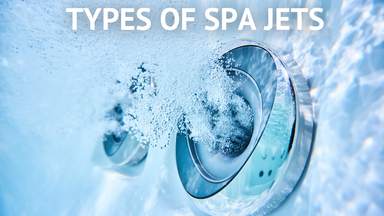Types of Spa/Hot Tub Jets
Published by Matt Fichera on 12/04/2019
Posted in: Spas & Hot Tubs

Bathing in a hot tub is surely a great way to enjoy life and to improve your health. Soaking in hot water, with the bubbles set to the right intensity and directed towards body parts that need massaging has great therapeutic effects and extraordinary health benefits. But how do jets fit into the research process, and how should I go about finding ones that work for you? This article will help shed some light on this.
Researching Jets
When researching spas or hot tubs there’s several things to consider when assessing which model has the strongest jets. Equipment, such as pumps will impact strong jets. The more pumps the model has, the more horsepower, and the more power that is able to be sent to them. Another bit of information to research and ask about is plumbing. The more pipes contained in a model, the further the water has to travel, losing pressure along the way. In addition to this, the optimal mix of water and air will help harness the right amount of power along with the size of the jet opening. In general, smaller openings feel more powerful but another thing to consider is that the smaller the opening, the less the target area on your body will be. Lastly, it’s important to take into account the functionality and the mix of the jets within the spa or hot tub. What is meant by this is having too many jets that are designed to be extra powerful can lead to low water pressure and poor jet performance. It’s important to have a variety of jet types throughout the spa so you can enjoy different types of massages depending on your therapy needs each day.
Types of Jets
Rotational – Jets that are slow and strong. Air and water move in circles while loosening tired and sore upper body muscles like the shoulder blades.
Directional – Jets with a center section having the ability to move in a certain direction.
Rapid Pulsing Jets – Jets that consist of a center section with at least two holes. When water pressure is applied the center-section spins freely and alternates the water in each hole. The center may also consist of a straight bar running the length of the middle portion of the face that spins when water pressure is applied. These jets hold special benefits for the spine muscles providing a deep, tension relieving massage.
Kneading Jets – Jets that work in deliberate kneading movements helping to alleviate tense muscles in the lower back area.
Shower Jets – Jets that are small in size and deliver gentle pressure. They are great for lightly massaging the entire back area.
Deep Relief Jets – Jets which help to alleviate the knots that form in the muscles of the back as the results of stress. They can be directed to work the problem area precisely;
Targeted Therapy Jets – Jets located in the lower area of the spa, providing efficient, relaxing massages for the calf muscles.
Multi-Massage Jets – Jets consisting of many small holes that divide the water into individual streams.
Ozone/Cluster Jets – Jets that typically don’t contain a visible nozzle and can’t be adjusted. They are basically an open section that water and air flows through.
The jets within the spa should be correctly positioned so that they fall in line with the seating and can efficiently deliver hydrotherapy in a coordinated manner. Specific areas of the body should be easily targeted with very little movement or adjusting needed. As a spa owner, you should be able to count on getting relief when and where you need it so if you know you store stress is certain areas of your body, make sure the spas that you are considering have jets placed where you need them to be. More is not necessarily better. It’s a personal decision, so spend time thinking about what’s most important to you.

